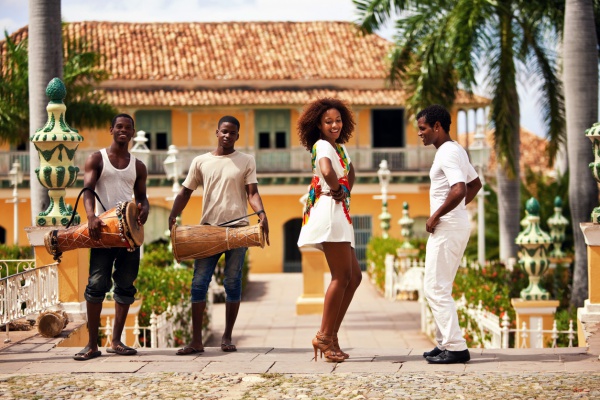The streets of Cali, Colombia throb with music. Whether you’re strolling the scenic riverfront or exploring the city’s historic architecture, pulsating rhythms float through every window and doorway. That’s because Cali is the “salsa capital of the world” and music and dance command a major part of the city’s lifestyle. Located southwest of Bogota the capital and Colombia’s third largest city, Cali is often overshadowed by flashier Medellin and Cartagena but this colorful metropolis offers a medley of can’t miss experiences. From music, to art, food and sugarcane history, Cali supplies a lively glimpse into Colombian culture.
RELATED: 7 charming pousadas in Brazil you can book now
Day 1: Salsa, discotecas and viejotecas
First things first: You can’t come to Cali and not try out its most famous attraction. Even if you’re rhythmically challenged, just sitting in one of the dozens of salsa clubs and absorbing the kinetic energy and scene is exciting. With the landmark Hotel Intercontinental Cali as your base, you can check out clubs in nearby hipster barrio San Antonio. But first sign up for a class in one of the city’s dance schools, like Live Salsa & Tango, where you’ll learn basic steps and twirls. Even if you’re a salsa pro, Cali salsa is like nothing seen stateside. The beat is about three times faster and the styles vary from old school footwork to up-in-the-air acrobatics. Go to La Topa Tolandra, Tin Tin Deo, Habanero Club and Changó for a taste of Caleño salsa style. To take a deeper dive into Cali’s salsa culture, visit a discoteca, which showcases original records, turntables, posters and dancing from the ’30s-’80s. Consider Bar Latino or Nelly Teca for the ultimate discoteca experience. Not a night owl? No problem, Cali supplies daytime salsa at viejotecas, which are clubs where seniors keep up their old school moves in the afternoon. You’ll see all ages at these clubs though and even septuagenarian Calenos boast smooth moves at Viejoteca Pardo Llada, so try to keep up.
Flickr CC: Mario Carvajal
Day 2: Museums, munchies and cats
Founded in 1536, Cali features a lot of fascinating history. A monument to the city’s recent history is El Gato Del Rio or River Cat, a three-ton bronze cat sculpture that sits chilling on the banks of the Cali River. Created by the famous Colombian sculptor Hernando Tejada, the cat represents the city’s nocturnal (salsa dancing) nature. Other artists created 15 smaller cats to form the Parque Del Gato or cat park, which is a cool sculpture garden lining the riverwalk. Head to the La Merced Anthropology Museum, which is housed in a medieval convent, to learn about indigenous artifacts and even a mummy. Across the street, the Museum of Religion, Ethnicity and Culture displays religious artifacts and exhibits highlighting the city’s prominent Afro-Colombian ethnic group. Around the corner, Museo del Oro Colima, or Gold Museum, displays over 400 pre-Hispanic golden objects, jewelry and ancient objects.
All that exploring is bound to work up an appetite and Cali serves up a diverse and budget-friendly dining scene. Be on the lookout for local faves like lulada, a drink with lulo fruit, lime and sugar, pandebono bread stuffed with cheese, aborrajados plantains stuffed with mozzarella and arroz atollado, a classic rich dish filled with chicken, pork, potatoes and lots of seasonings. Try the iconic diner Ringlete for gourmet versions of local classics or Pacifico Restaurante for Pacific coast delicacies.
ALSO: Earn rewards good toward more travel when you join Orbitz Rewards!
Flickr CC: Rodrigo Rodríguez
Day 3: Cultural treasures
Join the insightful Tia Stephanie Tours for an in-depth glimpse into Caleño culture. Start by stopping by Galeria Alameda, a sprawling market that sells everything from fresh fruits to live birds and kitchen utensils. Guided by a chef from Escuela Gastronomica de Occidente, you’ll select local ingredients like banana leaves, peppers and rice for the traditional Pacific Coast meal. Back at the school, learn about the influence of African cooking techniques and ingredients on Caleño cuisine. A scrumptious fish fillet cooked in banana leaves with rice is a foodie highlight.
A blinged out spectacle of Cali’s salsa history is on glitzy display at Ensalsate, a two-hour production bursting with color, music and dancing, which the audience naturally participates in at the end. If you visit Cali during August, it’s essential to visit the Petronio Alvarez Festival, which showcases the music, dances, foods and crafts of the Afro-Colombian Pacific coast. One of the biggest music fests in the country, the fest draws locals and tourists alike for four days with 60 live bands and non-stop dancing, which is the Cali way.
